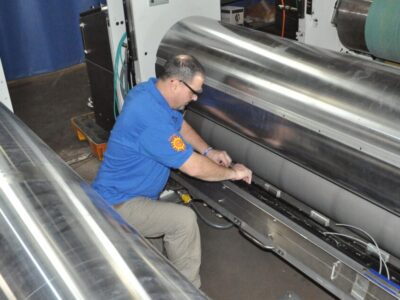A lot of thought, effort, and money is invested in making the machines at a corrugated facility run properly. Everything from repairs to routine maintenance and upgrades and innovations in equipment can do wonders for maximizing profit and minimizing downtime. There is, however, an often overlooked factor that has a detrimental impact on output efficiency, and it may be hiding in plain sight: the operators themselves.
A Common Problem
Most people in manufacturing, and corrugated specifically, are aware of some of the challenges facing their industry, based on employment trends: “the silver tsunami,” high turnover rate, and difficulty finding interested candidates. As baby boomers – who still make up a disproportionately high percentage of the workforce in corrugated – retire in greater numbers and at a faster rate, a wealth of institutional knowledge is leaving the manufacturing floor along with them. This trend has been even further exacerbated by the fallout surrounding the COVID-19 pandemic, which has hastened retirement of employees of ages deemed to be higher risk by the CDC. This recent trend has expanded beyond boomers – there is a markedly higher turnover rate across generations over the past year plus, as people have begun to rethink their employment needs and goals. Even before the COVID-19 pandemic, manufacturing operations were having a more difficult time enticing millennial and Gen-Z workers into roles at plants, on account of the hours, the heat and the dirtiness of the facilities, and other differing generational sensibilities regarding employment. The trickle-down effect of these employment trends to the operator training is that there is often a higher turnover rate of machine operators. Many companies may consider it to be more expensive and more time consuming to properly train operators, especially if they do not have confidence that they’ll stay in the job for very long. So instead, they have previous or outgoing operators train their replacements. Unfortunately, this turns machine operation protocol into a proverbial game of “telephone,” where each trainee is receiving less and less information straight from the source. Operators may be fully capable of explaining and passing on the day to day operation techniques, but in many cases, they have little or even no experience dealing with certain types of issues that arise less frequently, many of which require specialized knowledge to rectify. Worst of all, the trainees are generally new to this type of role, so they often don’t know what they don’t know. This makes it difficult for them to ask the right questions or know how to address what problems may arise after their trainer is long gone, when they are on their own.
Most people in manufacturing, and corrugated specifically, are aware of some of the challenges facing their industry, based on employment trends.
The Operator Holds The Power
There are a lot of nuances and intricacies to corrugated operations that make them run properly. But a major problem comes from machine operators not being properly trained by OEMs. This problem often flies under the radar because it is possible to operate machines on a basic or even intermediate level without a full training from an OEM. This may lull both the operator and the owners and managers of the facility into a false sense of security because daily operations will not likely suffer to the naked eye. However, without proper training, in many cases, while operators learn how to do the basics, they are not experienced in fine-tuning the process, which is essential to unlocking maximum efficiency. This can lead to problems as natural wear and tear occurs on parts, as these novice operators do not know how to fine-tune machines or how to interpret the underlying causes of issues like jams-ups, compromised speed, or sub-standard end products. These operators also often do not know the value of certain parts or components either, so it is not uncommon to see substandard practices, such as operators throwing print plates on the floor, not realizing that they are damaging equipment that costs thousands of dollars to repair. Worst of all, the lack of high-level operational knowledge means that output speed may not be maximized, or production quality may be sub-optimal. This means that operators are actually unwittingly costing the business money by compromising margins, and although this may be imperceptible to the untrained eye, it has the potential to leave thousands or even millions of dollars on the table annually. The telltale sign of untrained operators reveals itself when OEMs are on sight for repairs. Oftentimes, these OEMs will ask the machine operators questions about why a particular component is on so tightly, or why certain things are set up the way that they are, and the untrained operators simply do not know the answer. They commonly reply, “It’s always been this way” or “It seemed to be running just fine, so I didn’t want to mess with it.” The reality is that these operators are treading water in the deep end of the pool without ever having learned how to swim properly.
Even before the COVID-19 pandemic, manufacturing operations were having a difficult time enticing millennial and Gen-Z workers into roles at plants.
The Benefits of OEM Training
At SUN, our technicians get fewer calls for OEM operator training than nearly any of our other services. Without understanding the benefits of the training or the risks and costs stemming from improper training, operations see the training as an unnecessary expense, and believe that they can save money by not paying for a full training. However, a full OEM training pays for itself because it empowers operators to make the machines run more efficiently and read and address the warning signs of underlying issues before they become major breakdowns or catastrophic failures – a double-edged sword that both costs money to fix and loses out on money while machines are down for repairs. These trainings go beyond simply turning a machine on and off, as they focus on teaching trainers the “why” behind certain more esoteric adjustments and more subtle warning signs of a machine that is under undue stress or performing at a substandard level. It is never too late for OEM training, even if a machine operator has been on the job for months or even years, because there is always room to learn more about these elaborate, powerful and highly customizable, and adaptable machines. To learn more about OEM training and how it can improve your operations, contact a SUN service representative.
It is never too late for OEM training, even if a machine operator has been on the job for months or even years, because there is always room to learn more about these elaborate, powerful and highly customizable and adaptable machines.
Mark Peyton is the Director of Aftermarket at SUN Automation Group. He brings decades of industry experience and expertise to SUN where he has held many customer-focused positions. Prior to his 20-year career with SUN, he worked from Langston and United. He can be reached at mpeyton@sunautomation.com or 410-472-2900
Originally published in Corrugated Today, September/October 2021 Issue


 SUN Automation Group Proves Strong Partners Create Strong Solutions
SUN Automation Group Proves Strong Partners Create Strong Solutions